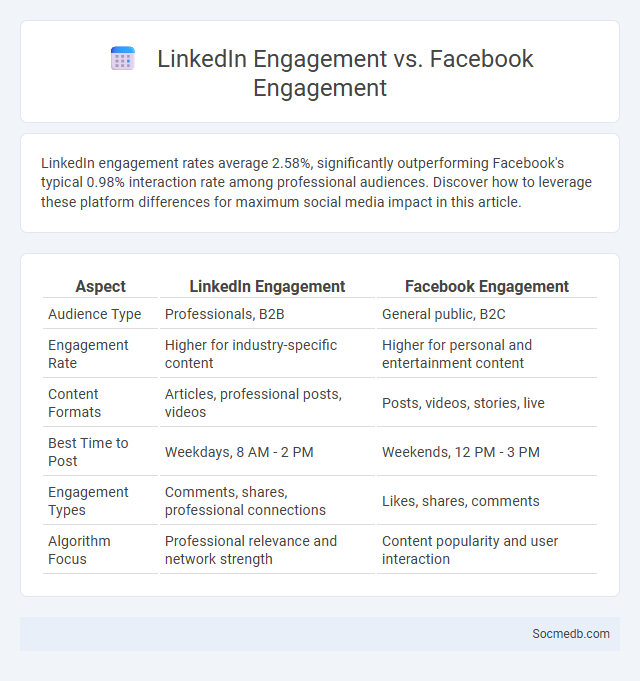
Photo illustration: LinkedIn Engagement vs Facebook Engagement
LinkedIn engagement rates average 2.58%, significantly outperforming Facebook's typical 0.98% interaction rate among professional audiences. Discover how to leverage these platform differences for maximum social media impact in this article.
Table of Comparison
| Aspect | LinkedIn Engagement | Facebook Engagement |
|---|---|---|
| Audience Type | Professionals, B2B | General public, B2C |
| Engagement Rate | Higher for industry-specific content | Higher for personal and entertainment content |
| Content Formats | Articles, professional posts, videos | Posts, videos, stories, live |
| Best Time to Post | Weekdays, 8 AM - 2 PM | Weekends, 12 PM - 3 PM |
| Engagement Types | Comments, shares, professional connections | Likes, shares, comments |
| Algorithm Focus | Professional relevance and network strength | Content popularity and user interaction |
Understanding Social Media Engagement
Social media engagement measures how users interact with your content through likes, comments, shares, and clicks, reflecting the effectiveness of your messaging. High engagement rates indicate a strong connection with your audience, boosting visibility and fostering brand loyalty. Monitoring these interactions helps you tailor content strategies to meet your followers' preferences and maximize online impact.
Overview of LinkedIn Engagement Metrics
LinkedIn engagement metrics include key indicators such as likes, comments, shares, and click-through rates, which measure user interaction and content effectiveness. Monitoring follower growth, post impressions, and profile visits provides insights into audience reach and brand visibility. Analyzing these metrics helps optimize LinkedIn content strategies to increase professional networking and lead generation.
Key Drivers of Facebook Engagement
Key drivers of Facebook engagement include compelling visual content, timely and relevant posts, and active community interaction. Your audience responds best to videos, images, and live streams that evoke emotions and encourage shares or comments. Consistent posting schedules combined with personalized responses to user interactions significantly boost reach and engagement metrics.
Comparing Feed Ranking Algorithms: LinkedIn vs Facebook
LinkedIn's feed ranking algorithm prioritizes professional relevance by emphasizing content from your connections, industry news, and job-related updates, enhancing your networking opportunities within specific career fields. Facebook's algorithm focuses on maximizing engagement by promoting posts from friends, family, and groups you interact with most, using a combination of user behavior signals like likes, comments, and shares to personalize your feed. Understanding these differences allows you to tailor your content strategy effectively for each platform, leveraging LinkedIn for professional growth and Facebook for social interaction.
Content Types That Boost Engagement on LinkedIn
LinkedIn engagement surges when you share a mix of content types such as industry insights, thought leadership articles, and real-life success stories that resonate with your professional network. Visual content like infographics and short videos significantly increase visibility and interaction by simplifying complex information and fostering authentic connections. Posting polls and questions encourages your audience to actively participate, thereby boosting your profile's algorithmic reach and strengthening Your professional brand.
Content Strategies for Facebook Audience Interaction
Effective content strategies for Facebook audience interaction include creating engaging multimedia posts such as videos and live streams that encourage comments and shares. Utilizing Facebook Insights to analyze audience behavior helps tailor content to user preferences, increasing reach and engagement rates. Posting consistently during peak times and incorporating interactive elements like polls and questions boosts user participation and fosters a loyal community.
Factors Influencing Feed Visibility on Both Platforms
Algorithms on social media platforms prioritize content based on user engagement, relevance, and recency, which significantly influences feed visibility on Facebook and Instagram. Factors such as post type, timing, frequency, and interaction history determine how often content appears in users' feeds. Advertisements and paid promotions further enhance visibility by bypassing organic reach limitations inherent in these platforms' ranking systems.
The Role of Personal Branding in Engagement
Personal branding significantly enhances social media engagement by establishing a unique and authentic online identity, which fosters trust and loyalty among followers. Consistent messaging and visual elements aligned with personal values and expertise attract targeted audiences, increasing interaction and shareability of content. Leveraging personal brand storytelling boosts emotional connection, encouraging meaningful conversations and sustained user participation across platforms like Instagram, LinkedIn, and Twitter.
Measuring Engagement Success: Tools and KPIs
Measuring engagement success on social media relies on key performance indicators (KPIs) such as likes, shares, comments, click-through rates, and follower growth, which provide quantitative insights into audience interaction and content effectiveness. Tools like Google Analytics, Hootsuite, Sprout Social, and Facebook Insights offer detailed analytics dashboards to track these KPIs in real time, enabling you to monitor trends and adjust strategies accordingly. By consistently analyzing these engagement metrics, your brand can optimize content performance and foster stronger connections with your target audience.
Optimizing Your Content for Maximum Feed Reach
Optimizing your social media content for maximum feed reach involves using targeted keywords, engaging visuals, and relevant hashtags to increase visibility and algorithm favorability. Posting consistently during peak activity times and encouraging user interaction through comments, likes, and shares further boosts organic reach. Leveraging platform-specific tools such as Instagram Stories or Facebook Insights enhances content performance and audience engagement.
 socmedb.com
socmedb.com